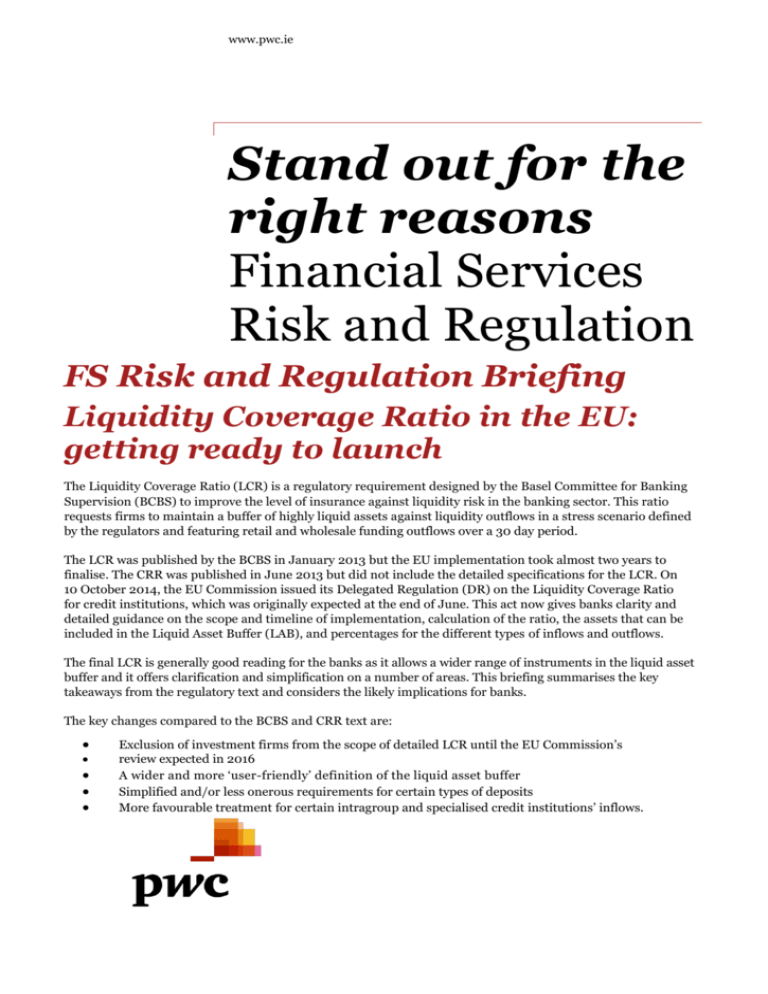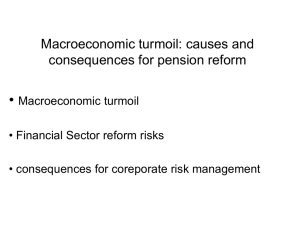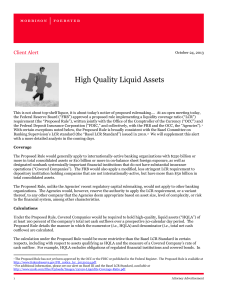
www.pwc.ie
Stand out for the
right reasons
Financial Services
Risk and Regulation
FS Risk and Regulation Briefing
Liquidity Coverage Ratio in the EU:
getting ready to launch
The Liquidity Coverage Ratio (LCR) is a regulatory requirement designed by the Basel Committee for Banking
Supervision (BCBS) to improve the level of insurance against liquidity risk in the banking sector. This ratio
requests firms to maintain a buffer of highly liquid assets against liquidity outflows in a stress scenario defined
by the regulators and featuring retail and wholesale funding outflows over a 30 day period.
The LCR was published by the BCBS in January 2013 but the EU implementation took almost two years to
finalise. The CRR was published in June 2013 but did not include the detailed specifications for the LCR. On
10 October 2014, the EU Commission issued its Delegated Regulation (DR) on the Liquidity Coverage Ratio
for credit institutions, which was originally expected at the end of June. This act now gives banks clarity and
detailed guidance on the scope and timeline of implementation, calculation of the ratio, the assets that can be
included in the Liquid Asset Buffer (LAB), and percentages for the different types of inflows and outflows.
The final LCR is generally good reading for the banks as it allows a wider range of instruments in the liquid asset
buffer and it offers clarification and simplification on a number of areas. This briefing summarises the key
takeaways from the regulatory text and considers the likely implications for banks.
The key changes compared to the BCBS and CRR text are:
Exclusion of investment firms from the scope of detailed LCR until the EU Commission’s
review expected in 2016
A wider and more ‘user-friendly’ definition of the liquid asset buffer
Simplified and/or less onerous requirements for certain types of deposits
More favourable treatment for certain intragroup and specialised credit institutions’ inflows.
A wider and more ‘userfriendly’ definition of the
liquid asset buffer
Compared to the BCBS definition of the LCR, the
following areas have been changed in the respect of
the LAB.
The LAB includes a wider range of
securitisations in addition to residential
mortgage backed securities (RMBS), such as
auto loans, consumer credit and Small and
Medium Enterprises (SME) loans.
Regarding operational requirements, the DR
indicates that liquid assets do not necessarily
need to be in a separate pool under the
control of the liquidity management function
(LMF), if internal systems and controls are in
place for the LMF to access the assets at any
point during the 30 day stress period. It
clarifies that the ability to monetise assets
through repo agreements equates to the
‘power to liquidate’.
The text provides a definition of the stress
scenarios under which a firm may use its
liquid asset buffer.
It also states that the valuation of liquid
assets should be their market value net of
any haircut.
Finally, it is worth noting that the DR
clarifies potentially confusing terminology,
indicating that ‘extremely high liquidity and
credit quality assets’ and ‘high liquidity and
credit quality assets’ correspond to level 1
and level 2 assets as used in the BCBS text,
and it uses the latter terminology in the rest
of the text.
The following assets can be included in the LAB:
Level 1 assets (assets not included in the BCBS
definition are marked with *)
PwC
Coins and banknotes
Exposures to or guaranteed by the ECB or a
Member State (MS)’s central bank
Exposures to or guaranteed by centrals banks
if they or central government rated External
Credit Assessment Institution (ECAI) 1
Exposures to MS Public Sector Entities
(PSEs) and to central or regional
governments, local authorities of MS and of
ECAI 1 rated third countries
Exposures to or guaranteed by central
government or central bank of third country
not ECAI 1 rated if to cover outflow incurred
in same currency or in jurisdiction where
liquidity risk is taken
Assets issued by credit institutions if
institution guaranteed by MS local or central
government or if institution is promotional
lender subject to additional criteria*
Certain ECAI 1 rated covered bonds which
must meet additional criteria including a
€500m size, a 2% overcollateralization and a
7% minimum haircut. Those are also subject
to a cap at 70% of the total liquid asset
buffer.*
Level 2 assets (assets not included in the BCBS
definition are marked with *)
Level 2A assets
These can make up to a maximum of 40% of the
liquidity buffer and are subject to a minimum 15%
haircut. They include:
Third country government bonds and bonds
issued by public entities with a 20% capital
risk weight
EU covered bonds with an ECAI 2 rating,
which must meet additional criteria
including a minimum €250m issue size, and
a 7% overcollateralization *
Non-EU covered bonds rated ECAI 1 with a
7% overcollateralization
Corporate bonds rated ECAI 1 with minimum
issue size of €250m and maximum initial
maturity of 10 years.
Level 2B assets
These can make up to a maximum of 15% of the
liquidity buffer and are subject to a minimum
haircut varying between 25 and 50% dependent on
risk profile and volatility. They include:
High quality securitisations for RMBS and
auto loans, subject to a 25% haircut
High quality securitisations for SME and
consumer loans subject to a 35% haircut*
Corporate bonds rated at least ECAI 3, with
minimum issue size of €250m and maximum
initial maturity of 10 years
Unrated high quality covered bonds, subject
to a 30% haircut*
Shares that are part of a major stock index
Restricted-use central bank committed
liquidity facilities
Deposits in cooperative and institutional
protection schemes, subject to a minimum
25% haircut, unless the central institution
holds or reinvests the deposits in liquid
assets of a higher level*.
Page 2 of 4
Finally collective investment undertakings (CIUs)
are subject to a look-through approach for the
underlying liquid assets with minimum haircuts for
each category of asset.
Operational deposits made
simpler
The determination of what constitutes an
operational deposit is key for firms as they attract a
lower outflow rate of 25%. Requirements in order
to identify those deposits have been significantly
simplified. In particular, an established operational
relationship is now defined as meeting all the
following criteria:
Pricing at least 5 bp below prevailing rate
Deposit is priced without economic
incentives to maintain funds in the account
The account sees material transactions on a
frequent basis
The relationship with the depositor has
existed for at least 2 years or the deposit is
used for at least 2 active services such as
payment services, security trading or
depository services.
And most importantly, the requirements for
evidence that operational functioning would be
compromised in case of fund withdrawal have been
removed.
Retail deposits outflows
redefined
In agreement with the Basel text, the Delegated Act
now allows firms to apply a 3% outflow factor to
retail deposits covered by a national deposit
guarantee scheme provided this scheme:
Has upfront funding
Can sustain a large call on its reserves
Ensures a seven working day repayment
period.
The onus on firms to come up with higher retail
deposits outflow rates is reduced, as the delegated
Act now prescribes outflow rates with two risk
buckets: 10-15% and 15 to 20%, depending on the
number of risk factors met by the deposit balance
in question, such as size, remuneration, depositor
residence/currency, and distribution channel.
PwC
Special treatment for
intragroup inflows and
specialised credit
institutions inflows
As in the Basel text, there is a cap on inflows equal
to 75% of expected outflows. However, there are a
number of exceptions that are specific to the EU:
There is a full exemption (no cap applied) for
inflows from banks belonging to the same
group or the same institutional protection
scheme.
And there is a full exemption for all inflows
from specialised credit institutions engaged
in leasing and factoring, with the caveat that
a 90% cap on auto and consumer leasing
inflows applies.
Scope and timeline
This detailed LCR will apply to banks on a solo and
consolidated basis.
The Regulation also states that the detailed LCR
does not apply to investment firms. The EBA will
prepare a report on the application of the LCR to
investment firms by the end of 2015. The
Commission will then report on the issue to the
Parliament and the Council, with a legislative
proposal if deemed necessary.
As required by the CRR, the LCR ratio is phased-in,
rising from 60% in 2015 to 100% in 2018. National
authorities may apply a higher ratio until the LCR
is fully phased-in.
Finally, given the time for legislative consideration
and industry preparation, the proposal suggests a 1
October 2015 implementation.
What’s next?
This more detailed guidance was an important
missing piece of the regulatory puzzle that banks
needed to get on with their implementation of the
LCR in the EU. Now what is left for regulators to do
is three-fold:
The European Banking Authority (EBA) will
need to revise its reporting templates
according to the new detailed rules and
banks will have to adjust their reporting
accordingly;
Page 3 of 4
The CBI will need to crystallize those changes
and clarify the steady state liquidity regime
for banks, especially regarding what will
happen to the liquidity reporting process
under the earlier regime.
What is the impact on
banks?
Although this DR does not contain any new
challenges, it is nevertheless essential for banks to
assess the impact of the finalised ratio on their
liquidity management and whether they need to
adjust their liquidity reserves or funding model
ahead of the phased-in implementation.
Banks have to watch out for the revised EBA
reporting templates and make sure those are
embedded in their reporting systems as soon
as possible.
Banks will also need to embed the new liquidity
ratio into their liquidity risk management
framework, for example in the definition of risk
appetite, in the MI used to monitor the liquidity
position of the firm and in their funds transfer
pricing methodologies.
The next 12 months are going to be key for banks
as they need to make sure they accurately capture
the data required and compute the ratios with the
appropriate degree of confidence to communicate
them to both supervisors and the public.
International banks must prepare for additional
complexities as the EU LCR requirement, as well as
the US implementation, differ from the Basel
requirement. They will have to report different
numbers to local supervisors, and be ready to
consolidate all the local requirements into a
consolidated LCR, making sure the strictest rules
at local level are reflected in the consolidated
number.
What do firms need to do
now?
Firms have already been working on their LCR
implementation for a while. Now that the ratio is
finalised, they need to revisit their LCR
implementation plan including:
Define policies for classifying assets,
inflows and outflows and calculating the
actual ratio
Update the assessment of the quantitative
impact on their balance sheet of the
finalised LCR
Adjust their risk appetite and risk
management framework to reflect the new
regulatory requirement
Adjust collateral management to the new
definition of the liquidity pool
Revise the liquidity transfer pricing regime in
order to be consistent with the LCR
Update their reporting systems once the
revised EBA templates are out.
Contacts
Garvan O’Neill
John Bligh
Kaustuv Banerjee
E: garvan.oneill@ie.pwc.com
E: john.bligh@ie.pwc.com
E: kaustuv.banerjee@ie.pwc.com
T: +353 1 792 6218
T: +353 1 792 6828
T: + 353 1 792 8441
PwC
Page 4 of 4
© 2014 PricewaterhouseCoopers. All rights reserved. PwC refers to the Irish member firm, and may
sometimes refer to the PwC network. Each member firm is a separate legal entity. Please see
www.pwc.com/structure for further details.
This content is for general information purposes only, and should not be used as a substitute for
consultation with professional advisors.










